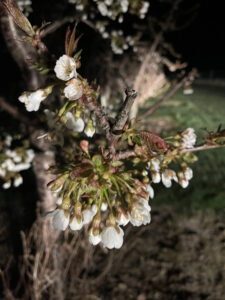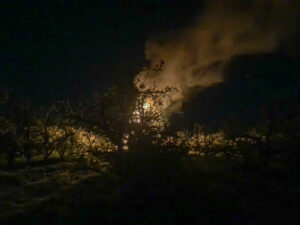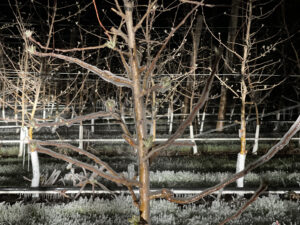Ag Marketing Spotlight: The Fight to Save the Apple Orchards
 Every year, Michiganders find delight in the sudden rise of temperatures we occasionally see in early Spring. Specialty crop growers don’t always feel that same joy which is why so many growers are fighting to save the apple orchards.
Every year, Michiganders find delight in the sudden rise of temperatures we occasionally see in early Spring. Specialty crop growers don’t always feel that same joy which is why so many growers are fighting to save the apple orchards.
Growing up on an apple farm, I always knew that those 70° days in late March or early April meant the trees would come out of dormancy earlier than we would like. Every time this happens, we start frantically watching the degree days and growth stages.
Nine years ago, Michigan experienced an economic disaster that wiped out most of the apple crop. We had warm weather in March and that was followed by over 17 days of cool temperatures and frost in late April when apples were in full bloom. When the temperature dips below 25° and your apple buds are opening, you can almost always expect crop damage or loss. The Spring of 2012 is still fresh in every grower’s mind and has caused the industry to implement many forms of defense to protect their crops from damaging frosts. This month we watched the weather charts trend in a dangerous direction, once again with critical low temperatures expected for several nights in a row. Apple growers anxiously watched the temperature models at the various weather stations that MSU Extension has established throughout the growing region.

Last Tuesday, I headed out to the orchards around 3 am with coffee in hand. It is a surreal sight to see fires burning throughout the area and frost fans buzzing in nearly every orchard. The fans try to bring warmer air down from the atmosphere; sometimes even a 1° change could save apple buds. Another technique growers have adopted is the use of micro-sprinklers. These sprinklers pump approximately 40 gallons of water per minute, per acre onto the trees. The goal is to create a microclimate in the lower canopy of the tree where it is the coldest.
The water coming out of the well is around 50° and it is releasing heat as it cools to match the air temperature. This process must be managed carefully, as you want the ice to melt naturally. They do so by continuously adding water to increase the energy of the fruit tissue and mitigate damage. In addition, apple trees have some natural defense mechanisms such as foliage, as well as the soil and grass within the orchard rows which help to retain heat. Large fires are burned to push smoke through the orchards with hopes that it too, will bring the temperature up slightly.
 By the end of the week, everyone was exhausted but hopeful. Throughout the region, apple growers felt optimistic the efforts they put in place lessened the effects of the frost. Within the next few days, we will be able to tell if our orchard incurred any damage. To assess the damage, we cut through the apple bud and checked the pistil. If it is brown or black, you have frost injury. Sometimes only the king (center) bud will be affected, as it is usually the first to emerge.
By the end of the week, everyone was exhausted but hopeful. Throughout the region, apple growers felt optimistic the efforts they put in place lessened the effects of the frost. Within the next few days, we will be able to tell if our orchard incurred any damage. To assess the damage, we cut through the apple bud and checked the pistil. If it is brown or black, you have frost injury. Sometimes only the king (center) bud will be affected, as it is usually the first to emerge.
The lateral buds will often survive with minimal injury. A minor frost can sometimes be nature’s way of thinning the crop, so you do not have an abundance of small apples. By late summer we will start to see the effects of frost injury on fruit, which will appear like scars. These apples do not usually meet the standard for USDA fresh grade; therefore, they go to processing and are turned into apple juice, cider, sauce, etc.
The 10-day forecast ahead is a sigh of relief. Growers can focus their efforts on pollination, planting new orchards, and critical sprays for pests and diseases. After all, spring (snow) showers are supposed to bring May flowers.
Follow BelleHarvest on Instagram @takebackthesnack for more pictures of the apple growing season in Michigan.
Discover how Gate 39 Media supports agribusinesses, clients, through inbound marketing and custom agricultural technology solutions.
Contact Gate 39 Media or talk with Ag Marketing Strategist, Kaitlin Vrsek, to discover what’s possible.
—
BE SURE TO CHECK BACK AND FOLLOW OUR #WORKINGREMOTELY SERIES
You may also be interested in:

